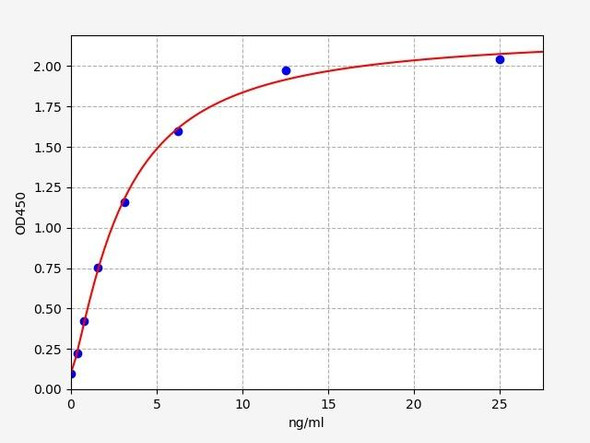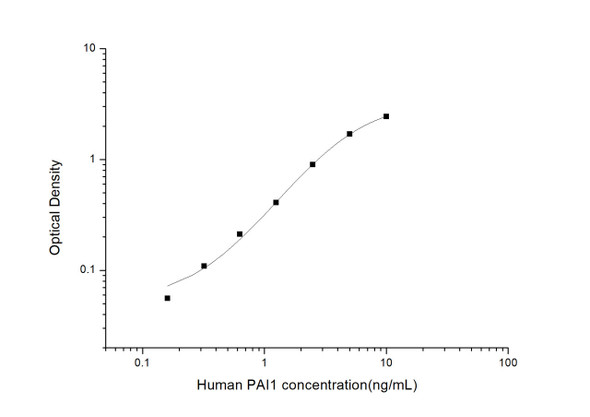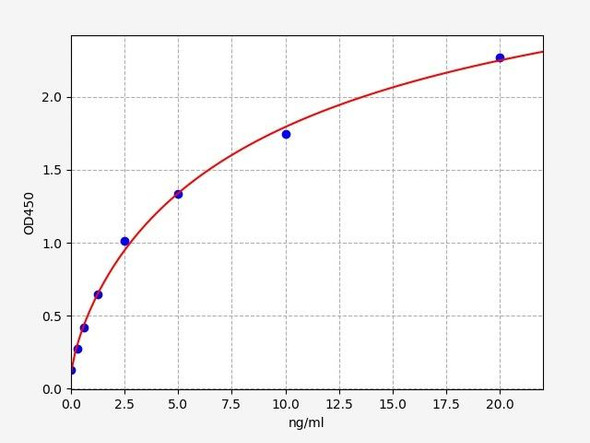Human Cell Biology ELISA Kits 5
Human PAI1 (Plasminogen Activator Inhibitor 1) CLIA Kit (HUES01122)
- SKU:
- HUES01122
- Product Type:
- ELISA Kit
- ELISA Type:
- CLIA Kit
- Size:
- 96 Assays
- Sensitivity:
- 18.75pg/mL
- Range:
- 31.25-2000pg/mL
- ELISA Type:
- Sandwich
- Reactivity:
- Human
- Sample Type:
- Serum, plasma and other biological fluids
- Research Area:
- Cell Biology
Description
| Assay type: | Sandwich |
| Format: | 96T |
| Assay time: | 4.5h |
| Reactivity: | Human |
| Detection method: | Chemiluminescence |
| Detection range: | 31.25-2000 pg/mL |
| Sensitivity: | 18.75 pg/mL |
| Sample volume: | 100µL |
| Sample type: | Serum, plasma and other biological fluids |
| Repeatability: | CV < 15% |
| Specificity: | This kit recognizes Human PAI1 in samples. No significant cross-reactivity or interference between Human PAI1 and analogues was observed. |
This kit uses Sandwich-CLIA as the method. The micro CLIA plate provided in this kit has been pre-coated with an antibody specific to Human PAI1. Standards or samples are added to the appropriate micro CLIA plate wells and combined with the specific antibody. Then a biotinylated detection antibody specific for Human PAI1 and Avidin-Horseradish Peroxidase (HRP) conjugate are added to each micro plate well successively and incubated. Free components are washed away. The substrate solution is added to each well. Only those wells that contain Human PAI1, biotinylated detection antibody and Avidin-HRP conjugate will appear fluorescence. The Relative light unit (RLU) value is measured spectrophotometrically by the Chemiluminescence immunoassay analyzer. The RLU value is positively associated with the concentration of Human PAI1. The concentration of Human PAI1 in the samples can be calculated by comparing the RLU of the samples to the standard curve.
| UniProt Protein Function: | SERPINE1: a secreted protein that acts as 'bait' for tissue plasminogen activator, urokinase, and protein C. Its rapid interaction with TPA may function as a major control point in the regulation of fibrinolysis. Belongs to the serpin family. Interacts with VTN. Binds LRP1B; binding is followed by internalization and degradation. Plasma levels of PAI-1 and VCAM-1 together may be useful in predicting post-operative recurrence in patients with colorectal cancer. |
| UniProt Protein Details: | Protein type:Secreted, signal peptide; Motility/polarity/chemotaxis; Secreted Chromosomal Location of Human Ortholog: 7q22. 1 Cellular Component: extracellular matrix; extracellular space; extracellular region; plasma membrane Molecular Function:serine-type endopeptidase inhibitor activity; protein binding; protease binding; receptor binding Biological Process: circadian rhythm; transcription initiation from RNA polymerase II promoter; platelet activation; extracellular matrix organization and biogenesis; positive regulation of blood coagulation; transcription, DNA-dependent; negative regulation of blood coagulation; negative regulation of smooth muscle cell migration; defense response to Gram-negative bacterium; positive regulation of receptor-mediated endocytosis; regulation of cell proliferation; positive regulation of interleukin-8 production; fibrinolysis; positive regulation of angiogenesis; platelet degranulation; negative regulation of fibrinolysis; transforming growth factor beta receptor signaling pathway; gene expression; positive regulation of transcription from RNA polymerase II promoter; regulation of receptor activity; angiogenesis; chronological cell aging; blood coagulation; negative regulation of cell adhesion mediated by integrin; negative regulation of cell migration; positive regulation of inflammatory response Disease: Plasminogen Activator Inhibitor-1 Deficiency |
| NCBI Summary: | This gene encodes a member of the serine proteinase inhibitor (serpin) superfamily. This member is the principal inhibitor of tissue plasminogen activator (tPA) and urokinase (uPA), and hence is an inhibitor of fibrinolysis. Defects in this gene are the cause of plasminogen activator inhibitor-1 deficiency (PAI-1 deficiency), and high concentrations of the gene product are associated with thrombophilia. Alternatively spliced transcript variants encoding different isoforms have been found for this gene. [provided by RefSeq, Sep 2009] |
| UniProt Code: | P05121 |
| NCBI GenInfo Identifier: | 129576 |
| NCBI Gene ID: | 5054 |
| NCBI Accession: | P05121. 1 |
| UniProt Secondary Accession: | P05121,B7Z4S0, F8WD53, |
| UniProt Related Accession: | P05121 |
| Molecular Weight: | 43,404 Da |
| NCBI Full Name: | Plasminogen activator inhibitor 1 |
| NCBI Synonym Full Names: | serpin peptidase inhibitor, clade E (nexin, plasminogen activator inhibitor type 1), member 1 |
| NCBI Official Symbol: | SERPINE1 |
| NCBI Official Synonym Symbols: | PAI; PAI1; PAI-1; PLANH1 |
| NCBI Protein Information: | plasminogen activator inhibitor 1; serpin E1; endothelial plasminogen activator inhibitor; serine (or cysteine) proteinase inhibitor, clade E (nexin, plasminogen activator inhibitor type 1), member 1 |
| UniProt Protein Name: | Plasminogen activator inhibitor 1 |
| UniProt Synonym Protein Names: | Endothelial plasminogen activator inhibitor; Serpin E1 |
| UniProt Gene Name: | SERPINE1 |
| UniProt Entry Name: | PAI1_HUMAN |
As the RLU values of the standard curve may vary according to the conditions of the actual assay performance (e. g. operator, pipetting technique, washing technique or temperature effects), the operator should establish a standard curve for each test. Typical standard curve and data is provided below for reference only.
| Concentration (pg/mL) | RLU | Average | Corrected |
| 2000 | 53169 58273 | 55721 | 55693 |
| 1000 | 23486 24462 | 23974 | 23946 |
| 500 | 11247 10817 | 11032 | 11004 |
| 250 | 4974 5614 | 5294 | 5266 |
| 125 | 2797 2419 | 2608 | 2580 |
| 62.5 | 1405 1217 | 1311 | 1283 |
| 31.25 | 655 693 | 674 | 646 |
| 0 | 28 28 | 28 | -- |
Precision
Intra-assay Precision (Precision within an assay): 3 samples with low, mid range and high level Human PAI1 were tested 20 times on one plate, respectively.
Inter-assay Precision (Precision between assays): 3 samples with low, mid range and high level Human PAI1 were tested on 3 different plates, 20 replicates in each plate.
| Intra-assay Precision | Inter-assay Precision | |||||
| Sample | 1 | 2 | 3 | 1 | 2 | 3 |
| n | 20 | 20 | 20 | 20 | 20 | 20 |
| Mean (pg/mL) | 110.61 | 294.29 | 935.72 | 120.92 | 316.11 | 857.54 |
| Standard deviation | 12.60 | 34.79 | 104.71 | 13.94 | 28.67 | 92.36 |
| C V (%) | 11.39 | 11.82 | 11.19 | 11.53 | 9.07 | 10.77 |
Recovery
The recovery of Human PAI1 spiked at three different levels in samples throughout the range of the assay was evaluated in various matrices.
| Sample Type | Range (%) | Average Recovery (%) |
| Serum (n=5) | 97-111 | 103 |
| EDTA plasma (n=5) | 98-111 | 106 |
| Cell culture media (n=5) | 98-110 | 104 |
Linearity
Samples were spiked with high concentrations of Human PAI1 and diluted with Reference Standard & Sample Diluent to produce samples with values within the range of the assay.
| Serum (n=5) | EDTA plasma (n=5) | Cell culture media (n=5) | ||
| 1:2 | Range (%) | 90-104 | 90-104 | 84-99 |
| Average (%) | 98 | 96 | 90 | |
| 1:4 | Range (%) | 101-115 | 87-101 | 95-107 |
| Average (%) | 109 | 92 | 101 | |
| 1:8 | Range (%) | 88-99 | 92-104 | 92-109 |
| Average (%) | 94 | 98 | 100 | |
| 1:16 | Range (%) | 84-99 | 97-113 | 101-117 |
| Average (%) | 91 | 104 | 108 |
An unopened kit can be stored at 4°C for 1 month. If the kit is not used within 1 month, store the items separately according to the following conditions once the kit is received.
| Item | Specifications | Storage |
| Micro CLIA Plate(Dismountable) | 8 wells ×12 strips | -20°C, 6 months |
| Reference Standard | 2 vials | |
| Concentrated Biotinylated Detection Ab (100×) | 1 vial, 120 µL | |
| Concentrated HRP Conjugate (100×) | 1 vial, 120 µL | -20°C(shading light), 6 months |
| Reference Standard & Sample Diluent | 1 vial, 20 mL | 4°C, 6 months |
| Biotinylated Detection Ab Diluent | 1 vial, 14 mL | |
| HRP Conjugate Diluent | 1 vial, 14 mL | |
| Concentrated Wash Buffer (25×) | 1 vial, 30 mL | |
| Substrate Reagent A | 1 vial, 5 mL | 4°C (shading light) |
| Substrate Reagent B | 1 vial, 5 mL | 4°C (shading light) |
| Plate Sealer | 5 pieces | |
| Product Description | 1 copy | |
| Certificate of Analysis | 1 copy |
- Set standard, test sample and control (zero) wells on the pre-coated plate and record theirpositions. It is recommended to measure each standard and sample in duplicate. Note: addall solutions to the bottom of the plate wells while avoiding contact with the well walls. Ensuresolutions do not foam when adding to the wells.
- Aliquot 100 µL of standard solutions into the standard wells.
- Add 100 µL of Sample / Standard dilution buffer into the control (zero) well.
- Add 100 µL of properly diluted sample (serum, plasma, tissue homogenates and otherbiological fluids. ) into test sample wells.
- Cover the plate with the sealer provided in the kit and incubate for 90 min at 37 °C.
- Aspirate the liquid from each well, do not wash. Immediately add 100 µL of BiotinylatedDetection Ab working solution to each well. Cover the plate with a plate seal and gently mix. Incubate for 1 hour at 37 °C.
- Aspirate or decant the solution from the plate and add 350 µL of wash buffer to each welland incubate for 1-2 minutes at room temperature. Aspirate the solution from each well andclap the plate on absorbent filter paper to dry. Repeat this process 3 times. Note: a microplatewasher can be used in this step and other wash steps.
- Add 100 µL of HRP Conjugate working solution to each well. Cover with a plate seal andincubate for 30 min at 37 °C.
- Aspirate or decant the solution from each well. Repeat the wash process for five times asconducted in step 7.
- Add 100 µL of Substrate mixture solution to each well. Cover with a new plate seal andincubate for no more than 5 min at 37 °C. Protect the plate from light.
- Determine the RLU value of each well immediately.






